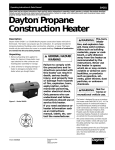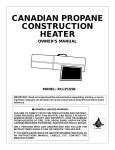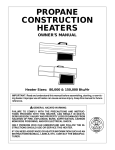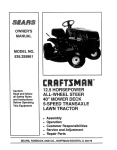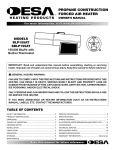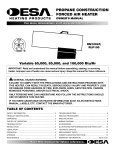Download Dayton 3VG78 Operating instructions
Transcript
Operating Instructions & Parts Manual 3VG78 Please read and save these instructions. Read carefully before attempting to assemble, install, operate or maintain the product described. Protect yourself and others by observing all safety information. Failure to comply with instructions could result in personal injury and/or property damage! Retain instructions for future reference. Dayton Natural Gas Construction Heater ® Description Dayton Model 3VG78 natural gas construction heater is a 150,000 Btu/Hr heater with built-in thermostat. This heater uses only natural gas for combustion. It is primarily intended for temporary heating of well-ventilated buildings under construction, alteration, or repair. This heater should only be used indoors but never in occupied dwellings. Products of combustion are vented into the area being heated. Unpacking 1. Remove all packing items applied to heater for shipment. Keep plastic cover caps (attached to inlet connector) for storage. 2. Remove all items from carton. 3. Check all items for shipping damage. If heater is damaged, promptly inform dealer where you bought heater. Figure 1 – Model 3VG78 GENERAL HAZARD WARNING Failure to comply with the precautions and instructions provided with this heater can result in death, serious bodily injury, and property loss or damage from hazards of fire, explosion, burn, asphyxiation, carbon monoxide poisoning, and/or electrical shock. Only persons who can understand and follow instructions should use or service this heater. If you need assistance or heater information such as an instruction manual, labels, etc. contact the manufacturer. Fire, burn, inhalation, and explosion hazard. Keep solid combustibles such as building materials, paper or cardboard, a safe distance away from the heater as recommended by the instructions. Never use the heater in spaces which do or may contain volatile or airborne combustibles, or products such as gasoline, solvents, paint thinner, dust particles, or unknown chemicals. Not for home or recreational vehicle use. The heater is designed for use as a construction heater. Other standards govern the use of fuel gases and heat producing products for specific uses. Your local authorities can advise you about these. The primary purpose of construction heaters is to provide temporary heating of buildings under construction, alteration or repair, and to provide temporary emergency heat. Properly used, the heater provides safe economical heating. Products of combustion are vented into the area being heated. We cannot foresee every use which may be made of our heaters. Check with your local fire safety authority if you have questions about heater use. Form 5S4250 ® Printed in U.S.A. 03430 0502/079/VCPVP Version B - For Reduction G016.J 3VG78 Dayton Operating Instructions and Parts Manual Dayton Natural Gas Construction Heater ® Specifications General Safety Information Output Rating ........................................ 150,000 Btu/Hr Make certain you read and understand all warnings. Keep these instructions for reference. They are your guide to safe and proper operation of this heater. Fuel ......................................................... Natural Gas Fuel Consumption ................................. 146 Cubic Ft/Hr (Vapor Only) Hot Air Output (CFM Approx) .............. 550 Motor ..................................................... 3,430 RPM Electric Input .......................................... 120V/60H, 1/8 HP Amperage .............................................. 2.2 Internal Regulator Output Pressure .... 4" WC (Factory Preset) Maximum Supply Pressure to Heater .. 1/2 psi Minimum Supply Pressure to Heater .. 5" WC Gas Inlet Connection ............................. 1/2" SAE Flare Ignition ................................................... Direct spark, interrupted type Net Weight ............................................. 24 Lb Shipping Weight ................................... 35 Lb Safety information appears throughout these instructions. Pay close attention to them. Below are definitions for the safety information listed throughout this manual. Under this heading, installation, operating and maintenance procedures or practices will be found that, if not carefully followed, WILL result in IMMEDIATE serious personal injury or death. Ignitor Gap (Inches) .............................. Minimum: 0.13" Maximum: 0.15" Temperature Control ............................. Built-In Thermostat Dimensions ............................................ 361/4"L x141/2"W x 20"H Product Identification Hot Air Outlet (Front) Upper Shell Under this heading, installation, operating, and maintenance procedures or practices will be found that, if not carefully followed, MAY result in minor personal injury, product or property damage. Handle Fan Guard Lower Shell Power Cord Thermostat Knob On/Off Switch Figure 2 - Product Identification Under this heading, installation, operating, and maintenance procedures or practices will be found that, if not carefully followed, MAY result in severe personal injury or death. 1/2" Inlet Connector 2 IMPORTANT: Not every possible circumstance that might involve a hazard can be anticipated. The warnings in this manual and on tags or decals affixed to the unit are therefore not all-inclusive. If a procedure, work method, or operating technique not specifically recommended by Dayton is used, you must make sure it is safe for you and others. You should also ensure that equipment will not be damaged or made unsafe by the operating or maintenance method you choose. Dayton Operating Instructions and Parts Manual Model 3VG78 General Safety Information (Continued) Carbon monoxide poisoning may lead to death! Some people are more affected by carbon monoxide than others. Early signs of carbon monoxide poisoning resemble the flu, with headaches, dizziness, and/or nausea. If you have these signs, the heater may not be operating properly, or the areas may not be sufficiently ventilated. Get fresh air at once! Have heater serviced. Natural Gas: Natural gas has a distinctive odor. This odor helps you detect a natural gas leak. However, the odor may fade. Natural gas may be present even though no odor exists. • Install and use heater with care. Follow all local ordinances and codes. In the absence of local ordinances and codes, refer to the National Fuel Gas Code handbook NFPA54/ANSI Z223.1 and the Natural Gas Installation Code, CAN/CGA B149.1. This instructs on the safe storage and handling of flammable gases. • Use only the electrical voltage and frequency specified on model plate. The electrical connections and grounding of the heater shall follow the National Electric Code, ANSI/ NFPA 70 or the Canadian Electrical Code, Part 1. • Electrical grounding instructions — This appliance is equipped with a three-prong (grounding) plug for your protection against shock hazard and should be plugged directly into a properly grounded three-prong receptacle or extension cord. • Use only natural gas. Do not attempt to operate on LP gas. • Locate heater on stable and level surface if heater is hot or operating. • Provide adequate ventilation. Before using heater, provide at least a three-square-foot opening of fresh, outside air for each 100,000 Btu/Hr of rating. This heater produces carbon monoxide, which is listed by the State of California as a reproductive toxin under Proposition 65. • Never block air inlet (rear) or air outlet (front) of heater. • For indoor use only. Do not use heater outdoors. • Keep heater away from strong drafts, wind, water spray, rain, or dripping water. • Do not use heater in occupied dwellings or in living or sleeping quarters. • Do not use heater in a basement or below ground level. Propane gas is heavier than air. If a leak occurs, propane gas will sink to the lowest possible level and may accumulate to explosive concentrations. • Keep appliance area clear and free from combustible materials, gasoline, paint thinner, and other flammable vapors and liquids. Dust is combustible. Do not use heater in areas with high dust content. • Minimum heater clearances from combustibles: Outlet: 8 Ft. Sides: 2 Ft. Top: 6 Ft. Rear: 2 Ft. • Check heater for damage before each use. Do not use a damaged heater. • Check hose (if used) before each use of heater. If highly worn or cut, replace with hose specified by manufacturer before using heater. • Keep heater away from strong drafts, wind, water spray, rain, or dripping water. • Never operate heater while unattended. • Keep children and animals away from heater. • This heater is equipped with a thermostat. Heater may start at anytime. • Never move, handle, or service a hot, or operating heater. Severe burns may result. You must wait 15 minutes after turning heater off. • To prevent injury, wear gloves when handling heater. • Never attach duct work to heater. • Do not alter heater. Keep heater in its original state. • Do not use heater if altered. • Turn off natural gas supply to heater and unplug when not in use. • Use only original replacement parts. This heater must use design-specific parts. Do not substitute or use generic parts. Improper replacement parts could cause serious or fatal injuries. ® 3 Version B - For Reduction G016.J 3VG78 Dayton Operating Instructions and Parts Manual Dayton Natural Gas Construction Heater ® Theory of Operation TEMPERATURE CONTROL SYSTEM Ventilation THE FUEL SYSTEM Built-in thermostat allows heater to cycle on and off to maintain consistent area temperature. Provide at least a three-square-foot opening of fresh, outside air while running heater. If proper fresh, outside air ventilation is not provided, carbon monoxide poisoning can occur. Provide proper fresh, outside air ventilation before running heater. The gas supply attaches to the heater by a minimum 3/4 inch i.d. hose or flexible connector. User must supply hose or flexible connector. The length should be no more than 10 feet long. The natural gas moves through the solenoid valve and the internal regulator and out the nozzle. THE AIR SYSTEM The motor turns the fan. The fan pushes air into and around the combustion chamber. This air is heated and provides a stream of clean, hot air. THE IGNITION SYSTEM The direct spark ignition system (DSI) sends voltage to the ignitor, which ignites the fuel and air mixture. THE SAFETY CONTROL SYSTEM This system causes the heater to shut down if the flame goes out. Natural Gas Supply The user must furnish the natural gas supply and the connections to the heater. Regulate the natural gas supply from a minimum 5 inches water column to a maximum of 1/2 psi. The natural gas supply capacity should be able to supply a minimum of 150 cubic feet of gas pressure for each heater connected to the system. Consult your natural gas supplier for proper sizing of the natural gas supply lines. Follow all local ordinances to codes. In the absence of local ordinances and codes, refer to the National Fuel Gas Code Handbook NFPA54/ANSI Z223.1 and the Natural Gas Installation Code, CAN/CGA B149.1. Motor Ignitor Fan Test all gas piping and connections for leaks after installing or servicing. Never use an open flame to check for a leak. Apply a mixture of liquid soap and water to all joints. Bubbles forming show a leak. Correct all leaks at once. 1. Provide natural gas supply system (See Natural Gas Supply). 3. Connect hose to heater at the 1/2 inch SAE flare fitting at the inlet. Internal Regulator Nozzle Review and understand the warnings in the Safety Information section, pages 2 and 3. They are needed to safely operate this heater. Follow all local codes when using this heater. 2. Install plumbing to a low pressure natural gas source. The source must be regulated to a maximum 1/2 psi. The plumbing must be a minimum 3/4 inch i.d. hose or flexible connector not over 10 feet long. Clean Heated Air Out (Front) Combustion Chamber Installation Power Cord On/Off Switch DSI Solenoid Valve Air For Combustion And Heating Hose Fuel 1/2" Inlet Connector Figure 3 - Cross Section Operational View Figure 4 - Hose and Inlet Connector 4 Dayton Operating Instructions and Parts Manual Model 3VG78 Installation (Continued) 4. Open natural gas supply valve slowly. 5. Check all connections for leaks. Never use an open flame to check for a leak. Apply a mixture of liquid soap and water to all joints. Bubbles forming show a leak. Correct all leaks at once. 6. Close natural gas supply. Operation Review and understand the warnings in the Safety Information section, pages 2 and 3. They are needed to safely operate this heater. Follow all local codes when using this heater. TO START HEATER 1. Follow all installation, ventilation and safety information. 2. Locate heater on stable and level surface. Make sure strong drafts do not blow into front or rear of heater. 3. Plug power cord of heater into a threeprong, grounded extension cord. Extension cord must be at least six feet long. Extension cord must be UL listed. EXTENSION CORD WIRE SIZE REQUIREMENTS Up to 50 feet long, use 18 AWG rated cord. 51 to 100 feet long, use 16 AWG rated cord. 101 to 200 feet long, use 14 AWG rated cord. 6. Turn thermostat control knob fully counterclockwise to the "COOLER" position. Turn ON/OFF switch to the ON position. Turn thermostat control knob slowly clockwise until electric motor and fan begin to run. Heater will start in approximately 3 seconds. Adjust thermostat control knob to WARMER or COOLER setting as needed. NOTE: If heater does not start after 3 seconds, the ignition control will automatically attempt to start heater one time. If heater fails to start on this attempt, the safety control will "lock out" and no further automatic restarts will be attempted. This could occur if air remains in fuel line. If heater fails to start on this attempt, turn ON/ OFF switch to OFF position. Wait ten seconds for safety control to reset, then turn ON/OFF switch back to ON position and try to start heater again. 7. Thermostat Operation Only: During normal thermostat operation, heater will cycle off when air temperature rises to thermostat setting. When air temperature drops sufficiently below thermostat setting, the electric motor and fan will begin to run. After 15 to 60 seconds, heater burner should automatically ignite and provide heat to maintain temperature setting. Storage Disconnect heater from natural gas supply. 1. Place plastic cover caps over brass fittings on inlet connector. 2. Store in dry, clean, and safe place. Do not store hose inside heater combustion chamber. 3. When taking heater out of storage, always check inside of heater. Insects and small animals may place foreign objects in heater. Keep inside of heater free from combustible and foreign objects. Maintenance Never attempt to service heater while it is plugged in, connected to natural gas supply, operating, or hot. Severe burns and electrical shock can occur. 1. Keep heater clean. Clean heater annually or as needed to remove dust and debris. If heater is dirty or dusty, clean heater with a damp cloth. 1. Tightly close natural gas supply valve. 2. Inspect heater before each use. Check connections for leaks. Apply mixture of liquid soap and water to connections. Bubbles forming show a leak. Correct all leaks at once. 2. Wait a few seconds. Heater will burn gas left in supply hoses. 3. Have heater inspected yearly by a qualified service person. 3. Turn on/off switch to the OFF position. 4. Keep inside of heater free from combustible and foreign objects. TO STOP HEATER 4. Unplug heater. 4. Plug extension cord into a 120 Volt/60 Hertz, three-hole, grounded outlet. 5. Open natural gas supply valve slowly. ® 5 Version B - For Reduction G016.J 3VG78 Dayton Operating Instructions and Parts Manual Dayton Natural Gas Construction Heater ® Maintenance (Continued) SERVICE PROCEDURES Never attempt to service heater while it is plugged in, connected to natural gas supply, operating, or hot. Severe burns and electrical shock can occur. 5. Dry blade thoroughly. 6. Replace fan blade on motor shaft. Make sure setscrew is touching back of flat surface on motor shaft (See Figure 7). 7. Place setscrew on flat of shaft. Tighten setscrew firmly (40-50 inch-pounds). 8. Replace fan guard and upper shell. Setscrew Fan Blade UPPER SHELL REMOVAL 1. Remove screws along each side of heater. These screws attach upper and lower shells together (See Figure 5). 2. Lift or slide upper shell off. 3. Remove fan guard. Motor shaft FAN LP-PFA/P 023 Figure 6 - Fan, Motor Shaft, and Setscrew Location Fan Hub Motor Shaft Setscrew Figure 5 - Upper Shell Removal FAN IMPORTANT: Remove fan blade from motor shaft before removing motor from heater. The weight of the motor resting on the blade could damage the fan pitch. 1. Remove upper shell (See Upper Shell Removal). 2. Use hex wrench to loosen setscrew which holds fan blade to motor shaft (See Figure 6).. 3. Slip blade off motor shaft. 4. Clean blade using soft cloth moistened with kerosene or solvent. FAN CROSS SECTION LP-PFA/P 013 Figure 7 - Fan Cross Section IGNITOR Make sure gap between ignitor electrode and burner nozzle is .13" min./.15"max. Access ignitor electrode from inside combustion chamber. No other maintenance is needed for ignitor. 6 Dayton Operating Instructions and Parts Manual Model 3VG78 Wiring Diagrams Green Black White Ignitor Blue Solenoid Valve Position of Leads May Vary Blue Orange G V VR ACR AC G V VR ACR AC Green White Insulated Connector Black Blue Blue White Black Position of Leads May Vary Motor Black Black High Temp Switch Black Green Automatic Ignition System Orange Automatic Ignition System Blue Blue Solenoid Valve Motor White T Line Figure 8 - Electrical Ladder Diagram Green or Green/Yellow Neutral On/Off Switch T Black Black Black White Thermostat Green Black Power Cord 120 VAC White Green Figure 9 - Electrical Connection Diagram ® 7 Version B - For Reduction G016.J 3VG78 3VG78 Dayton Operating Instructions and Parts Manual Dayton Natural Gas Construction Heater For Repair Parts, call 1-800-323-0620 ® 24 hours a day - 365 days a year Please provide following information: -Model number -Serial number (if any) -Part description and number as shown in parts list Address parts correspondence to: Grainger Parts P.O. Box 3074 1657 Shermer Road Northbrook, IL 60065-3074 U.S.A. 31 2 1 3 24 5 6 50 17 4 9 8 32 7 23 11 44 25 10 45 37 26 34 33 43 38 21 12 22 52 6 53 20 44 48 29 19 16 47 49 45 7 30 MA ¤ XITROL 35 20 40 15 51 36 28 39 42 46 18 41 14 8 27 Note: Screws areare standard hardware NOTE: Screws standard hardwareitems items Figure 10 - Repair Parts Illustration 8 13 Dayton Operating Instructions and Parts Manual Model 3VG78 Repair Parts List Use only original repair parts. This heater must use design-specific parts. Do not substitute or use generic parts. Improper repair parts could cause serious or fatal injuries. This will also protect your warranty coverage for parts replaced under warranty. Reference Number Description 1 Upper Shell 2 * #10-16 x 1/2" Screw 3 Combustion Chamber Kit 4 Nozzle 5 Ignitor 6 * #8-18 x 3/8" Screw 7 Fuel Tube Kit 8 Ignitor Cable 9 Heat Shield 10 Fan 11 Motor 12 Universal Bushing 13 Sleeve Cap 14 Male Connector 15 Solenoid Valve 16 Base 17 Baffle Washer 18 * #6-32 x 1" Screw 19 * #6-32 Hex Nut 20 * #10-16 x 1/2" Screw 21 Shorty Bushing 22 Shorty Bushing 23 Thermal Limit Switch 24 * #4-40 x 1/2" Screw 25 * #4-40 Captive Washer Hex Nut 26 Lower Shell 27 Side Cover 28 On/Off Switch 29 Wire Assembly 30 Regulator 31 Handle 32 * #10-16 x 3/4" Screw 33 Fan Guard 34 Motor & Relay Support Bracket Assy. 35 Strain Relief Bushing 36 Power Cord 37 Rubber Bumper 38 Lock Nut 39 3/16" Break Mandrell Rivet 40 Terminal Board Part No. 098511-129 100647-01 098512-53 103891-01 103934-01 M11084-38 099334-03 097806-02 M51108-01 M51153-01 105336-01 097776-01 078978-01 103401-01 103403-01 097966-12AA 078896-02 M12461-7 099432-01 M11084-27 M50104-05 M50104-01 101481-05 097968-05 097384-04 098511-116 098447-03 098226-01 079010-38 103406-01 M51104-01 M11084-29 097964-03AA 101206-01 M11143-1 098219-17 M50631 NTC-4C 099157-01 099125-01 Quantity 1 8 1 1 1 2 1 1 1 1 1 1 1 1 1 1 1 2 2 10 1 1 1 2 2 1 1 1 1 1 1 2 1 1 1 1 2 2 1 1 (*) Standard hardware item, available locally. ® 9 Version B - For Reduction G016.J 3VG78 Dayton Operating Instructions and Parts Manual Dayton Natural Gas Construction Heater ® Repair Parts List (Continued) Use only original repair parts. This heater must use design-specific parts. Do not substitute or use generic parts. Improper repair parts could cause serious or fatal injuries. This will also protect your warranty coverage for parts replaced under warranty. Reference Number Description 41 * #10-32 x 1/4" Screw 42 Union 1/2 NPT to 1/2 NPT Fitting 43 Clip Nut 44 High Temperature Wire Assembly 45 High Temperature Wire Assembly 46 Plug 1/8 NPTF Hex 47 * Hex TPG “F” 6-32 s 1/4" Screw 48 Built-in Thermostat 49 Thermostat Knob 50 Baffle Screw 51 DSI Control No. 2003-19 52 DSI Control No. 2003-45 53 DSI Wire Harness (DSI Control 2003-45 only) ∆ Wiring Decal (DSI Control 2003-45 only) ∆ Wiring Decal (DSI Control 2003-19 only) ∆ Wire Assembly (2003-45 only) ∆ Service Center List ∆ Tradename Decal ∆ General Information Decal ∆ Thermostat Decal ∆ Warning Decal ∆ NG Warning Decal Part No. M12461-25 103407-01 M11271-8 101480-10 101480-11 098276-01 M10908-1 097657-03 104905-01 103400-02 M51605-02 M51605-05 110267-01 103402-03 103402-01 M16841-20 M50985-01 099153-08 103886-02 103021-01 099504-01 103889-01 Quantity 2 1 8 1 1 1 2 1 1 1 1 1 1 1 1 1 1 2 1 1 2 1 (∆) Not shown. (*) Standard hardware item, available locally. LIMITED WARRANTY DAYTON ONE-YEAR LIMITED WARRANTY. Natural gas construction heater, Models covered in this manual are warranted by Dayton Electric Mfg. Co. (Dayton) to the original user against defects in workmanship or materials under normal use for one year after date of purchase. Any part which is determined to be defective in material or workmanship and returned to an authorized service location, as Dayton designates, shipping costs prepaid, will be, as the exclusive remedy, repaired or replaced at Dayton’s option. For limited warranty claim procedures, see PROMPT DISPOSITION below. This limited warranty gives purchasers specific legal rights which vary from jurisdiction to jurisdiction. LIMITATION OF LIABILITY. To the extent allowable under applicable law, Dayton’s liability for consequential and incidental damages is expressly disclaimed. Dayton’s liability in all events is limited to, and shall not exceed, the purchase price paid. WARRANTY DISCLAIMER. Dayton has made a diligent effort to provide product information and illustrate the product in this literature accurately; however, such information and illustrations are for the sole purpose of identification, and do not express or imply a warranty that the products are MERCHANTABLE, or FIT FOR A PARTICULAR PURPOSE, or that the products will necessarily conform to the illustrations or descriptions. Except as provided below, no warranty or affirmation of fact, expressed or implied, other than as stated in “LIMITED WARRANTY” above is made or authorized by Dayton. PRODUCT SUITABILITY. Many jurisdictions have codes and regulations governing sales, construction, installation, and/or use of products for certain purposes, which may vary from those in neighboring areas. While Dayton attempts to assure that its products comply with such codes, it cannot guarantee compliance, and cannot be responsible for how the product is installed or used. Before purchase and use of a product, review the product applications, and all applicable national and local codes and regulations, and be sure that the product, installation, and use will comply with them. Certain aspects of disclaimers are not applicable to consumer products; e.g., (a) some jurisdictions do not allow the exclusion or limitation of incidental or consequential damages, so the above limitation or exclusion may not apply to you; (b) also, some jurisdictions do not allow limitations on how long an implied warranty lasts, consequently the above limitation may not apply to you; and (c) by law, during the period of this Limited Warranty, any implied warranties of implied merchantability or fitness for a particular purpose applicable to consumer products purchased by consumers, may not be excluded or otherwise disclaimed. PROMPT DISPOSITION. Dayton will make a good faith effort for prompt correction or other adjustment with respect to any product which proves to be defective within limited warranty. For any product believed to be defective within limited warranty, first write or call dealer from whom product was purchased. Dealer will give additional directions. If unable to resolve satisfactorily, write to Dayton at address below, giving dealer’s name, address, date and number of dealer’s invoice, and describing the nature of the defect. Title and risk of loss pass to buyer on delivery to common carrier. If product was damaged in transit to you, file claim with carrier. Manufactured for Dayton Electric Mfg. Co., 5959 W. Howard St., Niles, Illinois 60714 U.S.A. Manufactured for Dayton Electric Mfg. Co. Niles, Illinois 60714 U.S.A. 10 ® 103888-01 Rev. E 05/02 Version B - For Reduction G016.J










